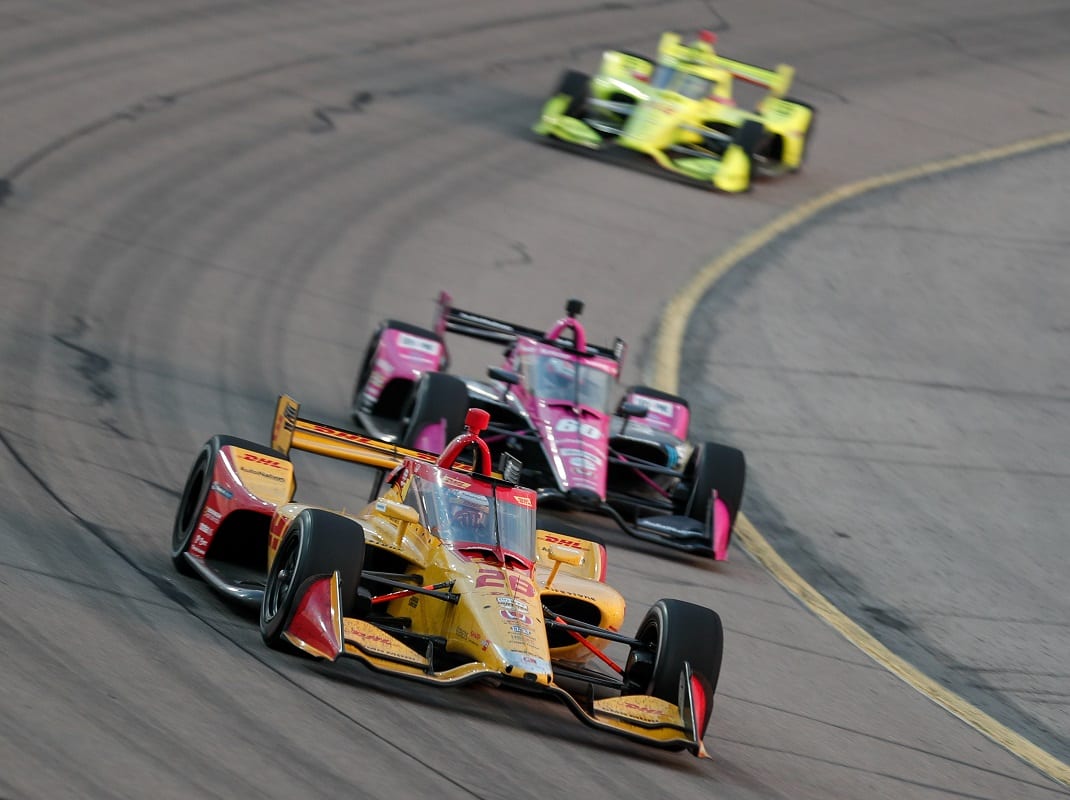NEWTON, Iowa – It has been decades since IndyCar drivers have raced on dirt, but several of them felt that way after last weekend’s Iowa IndyCar 250s at Iowa Speedway.
It wasn’t because of the track surface. If anything, the seven-eighths Iowa Speedway short oval provided some of the best racing of the season, especially in Friday night’s first race of the weekend doubleheader.
The reason many of the drivers were covered with dirt, sand, grit and bits of rubber after the two races came from an air scoop that was added on top of the aeroscreen to blow more air into the cockpit.
It was another way to try to lower air temperature inside the partially enclosed driver compartments because of the addition of the aeroscreen.
That safety device went a long way to proving how valuable it was in terms of safety in Friday night’s race alone. There were two incidents that could have been potentially catastrophic without the new safety addition.
The first came when a wheel nut came off the right front wheel on Will Power’s No. 12 Verizon Chevrolet. The wheel came off the car, then bounced directly in front of Power’s aeroscreen before sailing over to the inside of the track.
Although the wheel did not make contact with Power’s aeroscreen, it was a very close call and was reassuring to know that the screen was there to protect the driver.
“Man, I can’t thank IndyCar enough for everything they have done with the aeroscreen and halo inside of the aeroscreen,” Power said. “It’s better than anything in any other series like it.”
Just a few laps later, however, when the race was set to restart, Pato O’Ward got a large jump on the field, forcing IndyCar to wave off the restart. At the back of the field, Colton Herta heard “green” in his radio instead of “yellow” and got on the throttle.
Herta’s Honda ran into the back of Rinus VeeKay’s Chevrolet, then, up and over the aeroscreen before sailing into the air. VeeKay was protected by the safety device, which had its first major, on-track test in such a collision.
The gearbox on Herta’s Honda hit the top of the SAFER Barrier. The placement of the SAFER Barrier at Iowa Speedway is set an additional three feet in front of the fence, which adds another element of safety to the design of the track.
The additional area kept Herta’s Honda from digging into the fence, which would have likely torn down the fencing and sent Herta’s car into a wild, mid-air pirouette, similar to what happened to Robert Wickens at Pocono in 2018.
“I’m very happy with the safety,” said the 19-year-old VeeKay. “I stepped out and saw the aeroscreen was destroyed, but it did its job protecting me. Thanks to IndyCar for the safety.”
Team Penske’s Simon Pagenaud went on to win Friday night’s race in a dramatic “worst to first” performance after starting last on the 23-car grid.
When Pagenaud saw a car flying high in his mirrors Friday night, he was thankful every car was equipped with an aeroscreen.
“My first thought was thank God we’ve got the aeroscreen,” he said. “I’ve been in big favor of the aeroscreen for safety. Unfortunately, being around what happened to Justin Wilson (killed at Pocono in 2015) was really tough, really tough for everybody. Obviously being there and seeing it happen was extremely hard, so I’m so glad that IndyCar is doing everything they can to be the pioneer into a new level of safety, and I welcome it.”
NTT IndyCar Series points leader Scott Dixon was second and rookie Oliver Askew was third, the best finish of his IndyCar career.
“I don’t think I’ve ever been so dirty getting out of the car in my life, which means that it’s been moving some air into the cockpit,” Askew said after the race. “Props to IndyCar car for making the effort for sure.”
Dixon realizes that the aeroscreen project is an evolutionary process, which means it’s ongoing. When one problem is solved, another issue may develop.
To continue reading, advance to the next page.
